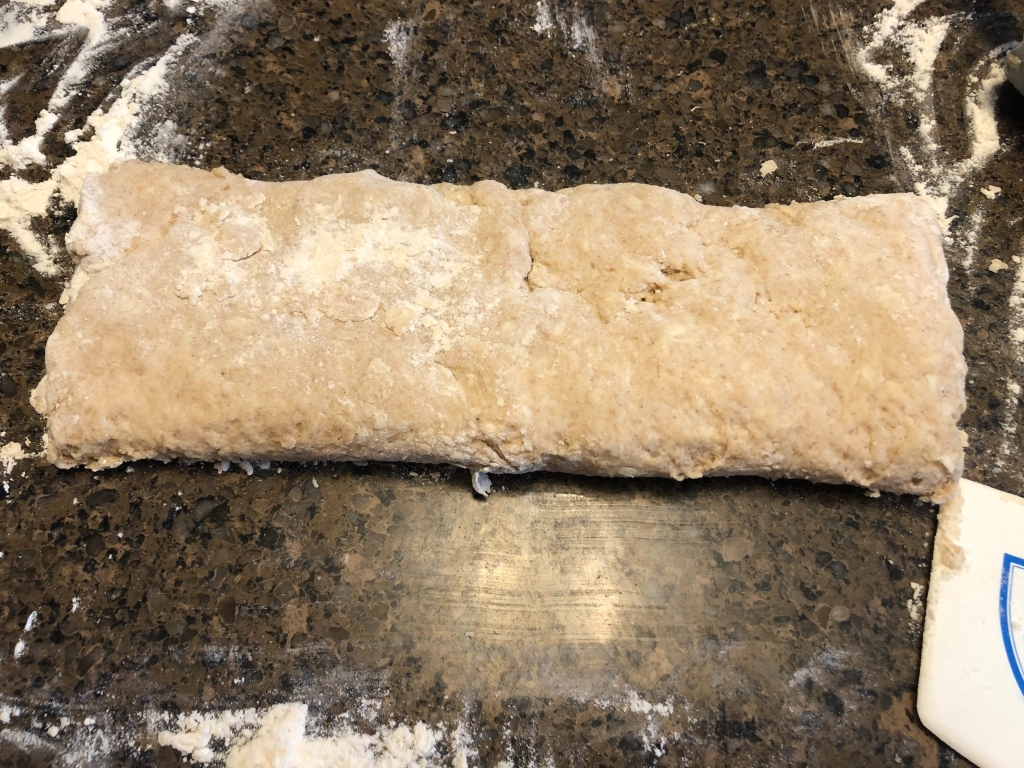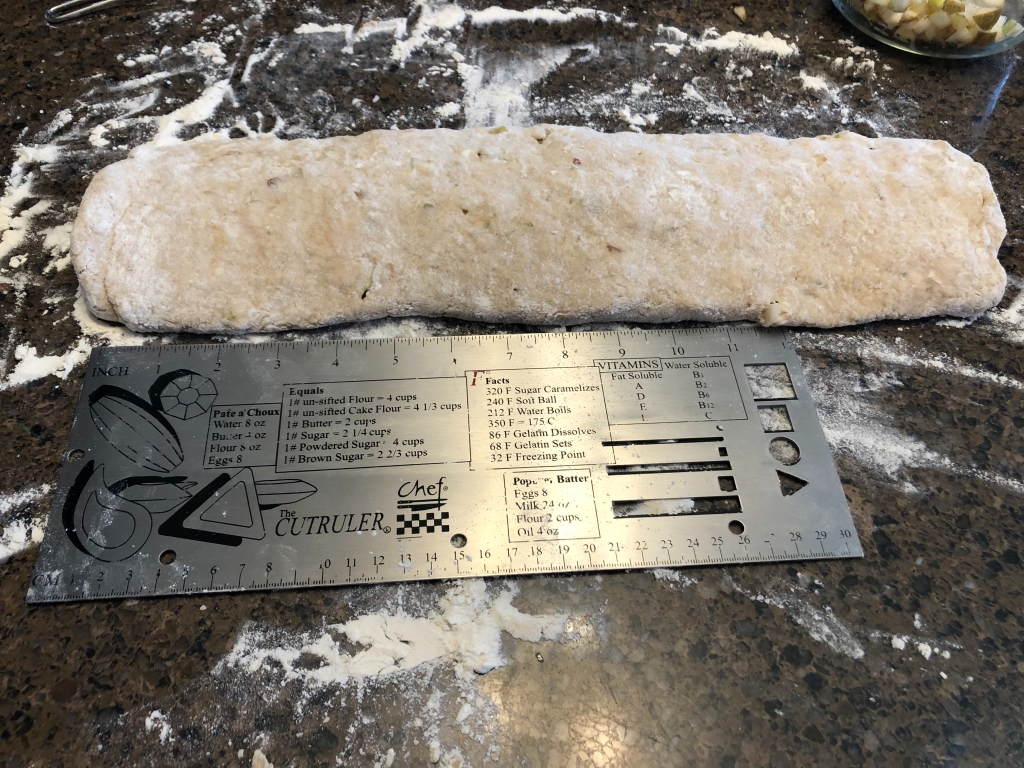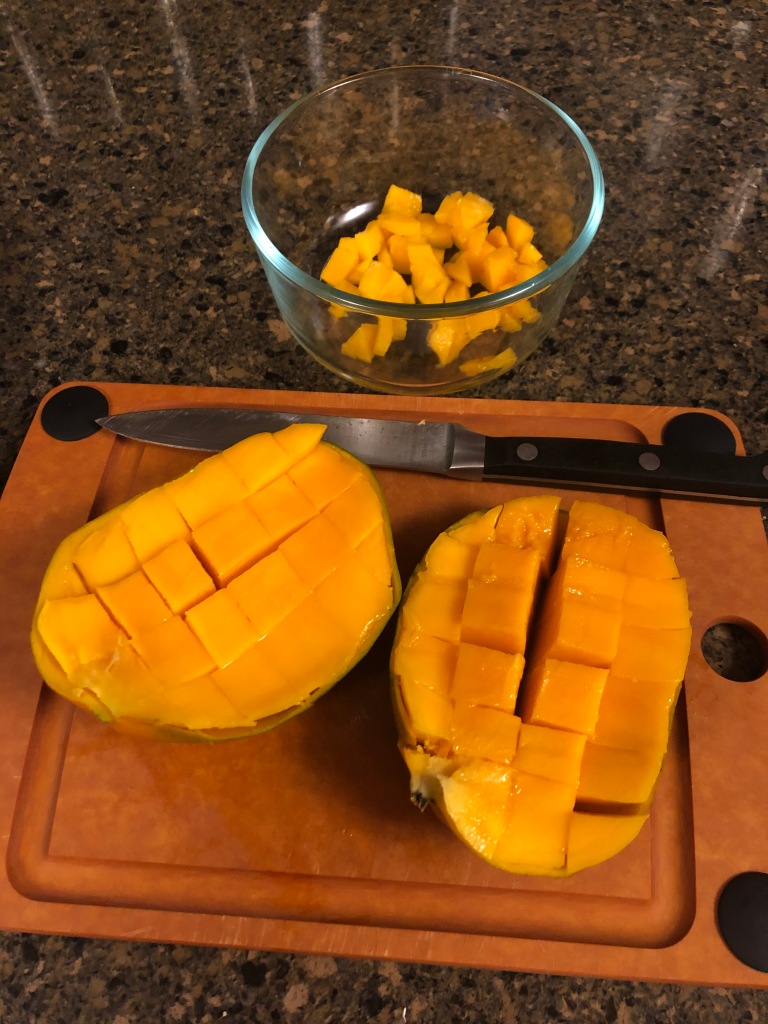You know that old saying When life gives you lemons, make lemonade? That’s cute and all, but I set much more store by this one: When your neighbor gives you pears, make pear scones.
I put pear in parentheses because the recipe actually calls for blueberries. I had blueberries on hand at the time of this baking, but I chose to pound them down by the fistful straight from the container rather then waste them in a scone. Summer is short in Minnesota. I have to get my fresh berry fix when and where I can.

Another reason pear is parenthetical is that the day after I made pear scones, I made a batch of mango-peach scones. So really, the recipe should be called Fill-in-the-Blank Scones.
I spent a good 20 minutes reading forgotten journal entries and perusing old travel photos of trips to England before something told me I should double-check myself. Lucky I did, because according to the infallible Internet, scones didn’t originate in England. They originated in Scotland. Great news: I’ve been there. Bad news: none of my pictures from that trip are digitized, necessitating a slog through several photo albums before I found what I was looking for.

Our visit to England’s northern neighbor can be described as a Scotland sandwich, nestled as it was between two slices of hearty English bread. A missed train in Carlisle meant an unexpected five-hour layover in gritty Glasgow, but it gave us a chance to tour the city’s famous necropolis.

We arrived in Fort William at 10:00 pm where we were surprised to find it was still dusk.

We ended our lightning fast tour of Scotland with a too-quick stay in Edinburgh that left many sights unseen.

I just remembered that this is supposed to be a recipe post. Here it is:
(Pear) Scones
Recipe Adapted From: Cook’s Illustrated Magazine, no. 87, p. 22
Level of Difficulty: Low
Time Consumption: Low
Kitchen Destruction: Moderate, but contained.

Wow Factor: Medium to high depending on who’s eating them. People expecting dry hockey pucks will be especially impressed. The neighbor who gave us the pears enthused, “I didn’t know I liked scones this much!” He wrote this on a piece of paper, attached it to a bag of apples picked from a tree in his yard, and left the bag on our front stoop. Is it just me, or is he expecting a slice of apple pie next?
Ingredients:
- 16 TBS (2 sticks) butter, frozen whole
- pears (I used about 9 small pears)
- ½ C whole milk
- ½ C sour cream
- 2 C unbleached all-purpose flour, plus more for work surface
- ½ C sugar, plus more for sprinkling
- 2 tsp baking powder
- ¼ tsp baking soda
- ½ tsp salt
- cinnamon and any other “autumn spice” spices you enjoy (cloves, nutmeg, etc.)
Directions:
Adjust oven rack to middle position and heat oven to 425°. Score and remove half the wrapper from each stick of frozen butter. Grate unwrapped ends on the large holes of a cheese grater, grating a total of 8 tablespoons.

Place grated butter in freezer until needed. Melt 2 TBS remaining butter and set aside. Save remaining 6 TBS butter for another use.

Whisk together milk and sour cream in medium bowl; refrigerate until needed. Whisk flour, ½ cup sugar, baking powder, baking soda, and salt in a medium bowl. Add frozen butter to the flour mixture and toss with fingers until thoroughly coated.
Add milk mixture to flour mixture; fold with spatula until just combined. With rubber spatula, transfer dough to liberally floured work surface; Dust surface of dough with flour; with floured hands, knead dough 6-8 times until it just holds together in a ragged ball, adding flour as needed to prevent sticking. Roll dough into approximate 12-inch square.

Fold dough into thirds like a business letter, using bench scraper or metal spatula to release dough if it sticks to the countertop.

Lift short ends of dough and fold into thirds again to form an approximate 4″ square.

Transfer dough to a plate lightly dusted with flour and chill in freezer for 5 minutes.
(Use these minutes to scroll through your social media. You know you want to.)
Transfer dough to a floured work surface and roll into approximate 12-inch square again. Sprinkle pears evenly over dough surface and press down so they are slightly embedded in the dough. Sprinkle to taste with cinnamon and other “autumn spice” spices.

Using a bench scraper or thin metal spatula, loosen dough from work surface. Roll dough, pressing to form a tight log.

Lay seam-side down and press log into a 12″ x 4″ rectangle.

Using sharp, floured knife, cut crosswise into four equal rectangles. Cut each rectangle diagonally to form 2 triangles and transfer to a parchment-lined baking sheet (preferably a rimmed sheet to catch butter drips).

Brush tops with melted butter (just a little on each scone or it will burn and, in my case, set off the smoke alarm) and sprinkle with sugar.

Bake until tops and bottoms are golden brown, 18-25 minutes. Transfer to a wire rack and let cool 10 minutes before serving.

Eat your fill and freeze the rest.
Confessions of an Imperfect Baker: Other than the measuring gaffes mentioned above, none!
Notes: If you decide to do mango-peach scones instead, leave off the autumn spices, unless experimenting with odd and potentially unpalatable flavor combinations is your raison d’être.




Grating frozen butter? A stroke of genius. A stick of butter, it turns out, is a purely American measurement. A friend asked me for a recipe once, and it included a stick of butter. She called to ask what one was. I can’t help thinking that she had a passing thought that I might be using it as a verb, not a noun.
LikeLiked by 1 person
That’s Cook’s Illustrated’s thing: make a recipe 500 times until you get it right, then write about the process and publish it with the recipe. I’m pretty sure the article that accompanied the recipe called the grated butter the key to making these scones perfect.
LikeLiked by 1 person
When I see Scotland and scone in a sentence I immediately think of the Stone of Scone. 😉 I can see from your photos that your scones are not stone-like and look darned delicious. I’ve never seen a measuring device like your Cutruler. Very interesting.
LikeLiked by 1 person
The Cutruler has many uses, most of which I totally ignore. 🙂
LikeLike
Well be that as it may, it’s clever and makes you look like a professional baker!
LikeLiked by 1 person
Well in that case, I’m going to put it in every Travel-Inspired Baking post, whether I use it or not. Ha ha!
LikeLiked by 1 person
Looks good! I don’t think I’ve ever had any kind of baked good made with pears.
LikeLiked by 1 person
Irish scones are not as big and risen as the English variety; they are usually smaller, less sweet and a little flatter, this just means you get to eat more than one. They are often made with buttermilk and sultanas (some people even add currant) and the way we eat them here is with lots of butter and jam! Your recipe sounds delicious, I’ve never tried a pear scone before. Thanks for sharing and have a good day. Aiva
LikeLiked by 1 person
I’ll have to try those when I get to Ireland someday.
LikeLiked by 1 person
Great posting, I adore scones. Do you have a tip about where in the relation to the 10 minute window of pear ripening (between rock hard vs brown mush) is best for baking?
I would think that a mango scone would be a massive nose thumbing to the culinary consistency squad, but too darn bad. It sounds delightful.
LikeLiked by 1 person
Thank you. Ha ha. You are giving pears a bad rap. The window is a good 20 minutes long.
LikeLike
Yum! I’ve made scones, but it never crossed my mind to make them with pears! Sounds like a good one, though, and I’ll have to try this recipe once I get my hands on some pears. Thanks for sharing! 🙂
LikeLiked by 1 person
You’re welcome. I think you’ll really like them.
LikeLiked by 1 person
Great post! Now I’m hungry and want to travel… (BTW- the best Apple pies come with cheddar cheese!)
LikeLiked by 2 people
Thank you! You know, I like apple pie, and I adore cheese, but that combo has never really appealed to me. Then again, I love a good white cheese (cheddar, brie, etc.) with grapes and wine, so go figure!
LikeLiked by 2 people
I, too, am baffled, and intrigued, by the concept of apple pie with cheese. I didn’t even know such a thing existed! Anna Williams, do tell more. 😊
LikeLiked by 1 person
I’ve never been a big dry hockey puck… I mean scone fan. I just couldn’t see the attraction. Your post reminded me of an awesome sweet/savory pear upside down cake recipe that I make in the fall. It’s now fall… yippee!
LikeLiked by 1 person
I do like upside-down cakes. I have a recipe for a mango-pineapple one, but I bet I could make it work with pears.
LikeLiked by 1 person
That sounds good. The one I make has pears for sweet and rosemary for savory.
LikeLike
I admire your bravado for taking on the scone challenge. I made scones once and they were immediately hijacked by the CIA to be used as lethal weapons! Never again! 🙂
LikeLiked by 1 person
Ha ha! That’s too bad. The magazine from which I got the recipe has a mission to make items a zillion times to improve them. They, too, noted that scones are usually hard and dry and they set out to remedy that, which, happily, they did.
LikeLiked by 1 person
Long may your baking mojo continue!
LikeLike
Those scones look amazing! I am far from a baker and usually my creations never turn out, but perhaps I’ll give this one a go!
LikeLiked by 1 person
Thanks for the comment. If you make them, I’d love it if you wrote back to let me know how they turn out.
LikeLike
I did not know something like pear scones existed. Thanks for sharing!
LikeLiked by 1 person
You’re welcome!
LikeLike
Ooh! I’ve never had a pear scone. Loving your Scotland photos by the way. 🙂 (Of course!!)
LikeLiked by 1 person
Thank you. I hoped they would meet with the approval of a real Scotswoman! 🙂
LikeLike
Despite living in Scotland all my life, I thought they were English. 🙈 Every day is a school day!
LikeLiked by 1 person
Pear is my favorite food. It’s look like taste.
LikeLiked by 1 person
😂😂 I love that you got distracted by your travel memories halfway through the post. It happens. 😁 Also, yummm….I never say no to a good scone. I’ve never tried pear, but I might now! 🤔
LikeLiked by 1 person
I get distracted by travel thoughts/travel fantasies/internal dialogue about travel all the time. It’s especially acute now, with the lack of travel! They are good scones – I hope you try them!
LikeLiked by 1 person
I miss travel, too! SO much!
LikeLike
Looks delicious!
LikeLiked by 1 person
Thank you!
LikeLiked by 1 person
We received a box of pears from Harry and David for Christmas. I wish I had seen your recipe then!
LikeLiked by 1 person